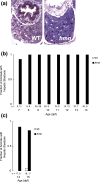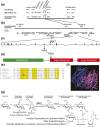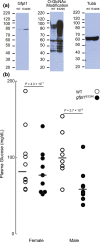A Genetic Model to Study Increased Hexosamine Biosynthetic Flux
- PMID: 28582574
- PMCID: PMC5551556
- DOI: 10.1210/en.2017-00359
A Genetic Model to Study Increased Hexosamine Biosynthetic Flux
Abstract
Recently, we identified harvest moon (hmn), a fully penetrant and expressive recessive zebrafish mutant with hepatic steatosis. Larvae showed increased triacylglycerol in the absence of other obvious defects. When we attempted to raise these otherwise normal-appearing mutants to adulthood, we observed a developmental arrest and death in the early juvenile period. In this study, we report the positional cloning of the hmn locus and characterization of the defects caused by the mutation. Using bulk segregant analysis and fine mapping, we find that hmn mutants harbor a point mutation in an invariant residue within the sugar isomerase 1 domain of the gene encoding the rate-limiting enzyme of the hexosamine biosynthetic pathway (HBP) glutamine-fructose-6-phosphate transamidase (Gfpt1). The mutated protein shows increased abundance. The HBP generates β-N-acetyl-glucosamine (GlcNAc) as a spillover pathway from glucose. GlcNAc can be O-linked to seryl and threonyl residues of diverse cellular proteins (O-GlcNAc modification). Although some of these O-GlcNAc modifications serve an essential structural role, many others are dynamically generated on signaling molecules, including several impacting insulin signaling. We find that gfpt1 mutants show global increase in O-GlcNAc modification, and, surprisingly, lower fasting blood glucose in males. Taken together with our previously reported work, the gfpt1 mutant we isolated demonstrates that global increase in O-GlcNAc modification causes some severe insulin resistance phenotypes (hepatic steatosis and runting) but does not cause hyperglycemia. This animal model will provide a platform for dissecting how O-GlcNAc modification alters insulin responsiveness in multiple tissues.
Copyright © 2017 Endocrine Society.
Figures



Similar articles
-
Hexosamines, insulin resistance, and the complications of diabetes: current status.Am J Physiol Endocrinol Metab. 2006 Jan;290(1):E1-E8. doi: 10.1152/ajpendo.00329.2005. Am J Physiol Endocrinol Metab. 2006. PMID: 16339923 Free PMC article. Review.
-
First characterization of glucose flux through the hexosamine biosynthesis pathway (HBP) in ex vivo mouse heart.J Biol Chem. 2020 Feb 14;295(7):2018-2033. doi: 10.1074/jbc.RA119.010565. Epub 2020 Jan 8. J Biol Chem. 2020. PMID: 31915250 Free PMC article.
-
A genetic screen for zebrafish mutants with hepatic steatosis identifies a locus required for larval growth.J Anat. 2017 Mar;230(3):407-413. doi: 10.1111/joa.12570. Epub 2016 Dec 15. J Anat. 2017. PMID: 27976367 Free PMC article.
-
Hexosamine biosynthesis and protein O-glycosylation: the first line of defense against stress, ischemia, and trauma.Shock. 2008 Apr;29(4):431-40. doi: 10.1097/shk.0b013e3181598bad. Shock. 2008. PMID: 17909453 Review.
-
Targeting the hexosamine biosynthetic pathway and O-linked N-acetylglucosamine cycling for therapeutic and imaging capabilities in diffuse large B-cell lymphoma.Oncotarget. 2016 Dec 6;7(49):80599-80611. doi: 10.18632/oncotarget.12413. Oncotarget. 2016. PMID: 27716624 Free PMC article.
Cited by
-
Zebrafish as an Emerging Model for Dyslipidemia and Associated Diseases.J Lipid Atheroscler. 2021 Jan;10(1):42-56. doi: 10.12997/jla.2021.10.1.42. Epub 2020 Dec 22. J Lipid Atheroscler. 2021. PMID: 33537252 Free PMC article. Review.
-
CaMeRe: A Novel Tool for Inference of Cancer Metabolic Reprogramming.Front Oncol. 2020 Feb 25;10:207. doi: 10.3389/fonc.2020.00207. eCollection 2020. Front Oncol. 2020. PMID: 32161720 Free PMC article.
-
Enzymatic assay for UDP-GlcNAc and its application in the parallel assessment of substrate availability and protein O-GlcNAcylation.Cell Rep Methods. 2023 Jun 28;3(7):100518. doi: 10.1016/j.crmeth.2023.100518. eCollection 2023 Jul 24. Cell Rep Methods. 2023. PMID: 37533645 Free PMC article.
-
Diverse myopathological features in the congenital myasthenia syndrome with GFPT1 mutation.Brain Behav. 2022 Feb;12(2):e2469. doi: 10.1002/brb3.2469. Epub 2022 Jan 3. Brain Behav. 2022. PMID: 34978387 Free PMC article.
References
-
- Kettleborough RN, Busch-Nentwich EM, Harvey SA, Dooley CM, de Bruijn E, van Eeden F, Sealy I, White RJ, Herd C, Nijman IJ, Fényes F, Mehroke S, Scahill C, Gibbons R, Wali N, Carruthers S, Hall A, Yen J, Cuppen E, Stemple DL. A systematic genome-wide analysis of zebrafish protein-coding gene function. Nature. 2013;496(7446):494–497. - PMC - PubMed
-
- Rauch G-J, Granato M, Haffter P. A polymorphic zebrafish line for genetic mapping. Tech Tips Online. 1997;2(1):148–150.
Publication types
MeSH terms
Substances
Grants and funding
LinkOut - more resources
Full Text Sources
Other Literature Sources
Molecular Biology Databases
Miscellaneous

